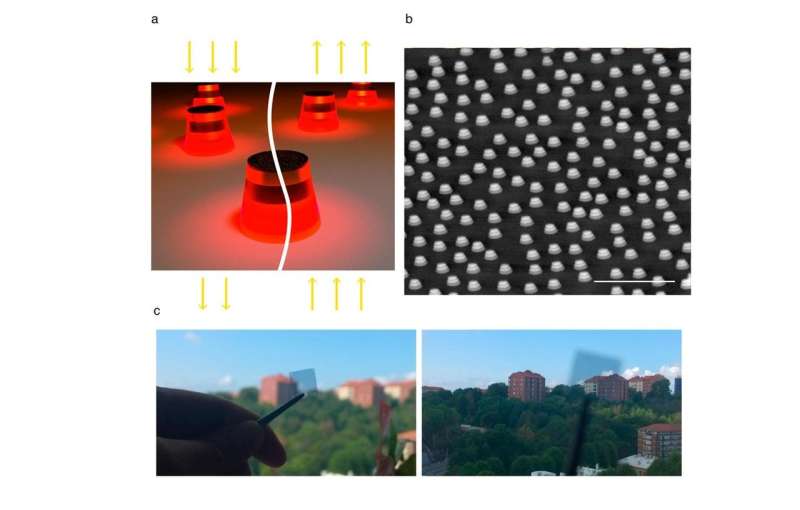(a) Artistic depiction of a nanoantenna surface. (b) Scanning electron microscope micrograph of the nanoantennas. (c) Photographs of the new surface held against a window. Credit: Jӧnsson et al. ©2017 American Chemical Society
Researchers have developed a way to transform ordinary windows into solar-powered heaters that use the sun's energy to increase the window temperature by up to 8 K (nearly 15 °F) in cold weather. The researchers expect that the new solar thermal surfaces will lead to significant energy savings through reduced heating costs.
The scientists, led by Alexandre Dmitriev at the University of Gothenburg, along with coauthors from universities in Sweden, China, Iran, and the US, have published a paper on the solar thermal surfaces in a recent issue of Nano Letters.
"We've developed a surprisingly simple, cheap, and effective way to transform regular glass windows into solar-powered heat-screens that could significantly change the thermal balance of living and working spaces, especially if one thinks of the ever increasing amount of huge glass surfaces used in modern architecture," Dmitriev told Phys.org.
The new surfaces are yet another application of nanotechnology, as the main functional components are plasmonic nanoantennas. The tiny antennas are made of nickel-aluminum oxide sandwiches, shaped like nanoellipses, and patterned as an array onto glass. With the help of electron oscillations, or surface plasmons, on the surfaces of these materials, the nanoantennas strongly absorb light, which heats the entire surface.
In the new study the researchers demonstrated that, when sunlight shines on the surface, light is absorbed more efficiently from the front side (with the antennas) than the back side (the substrate). This directionality in light absorption makes the surfaces attractive for window applications, as sunlight can be absorbed most efficiently from the outside of the window. In addition, the surfaces are highly transparent, appear colorless, and almost completely preserve the color spectrum of sunlight.
As the researchers explain, cold windows have a larger impact on heating a building than might be expected. This is because, when a person sits next to a cold window, the person radiates their body heat toward the window and the window acts like a "heat sink." To compensate for this loss of heat, the indoor temperature needs to be increased to maintain a comfortable environment. As the new window surface can increase the temperature of the window by several degrees, it has the potential to offer a large energy savings.
The researchers expect that the new surface may have other applications beyond windows. The nanoantennas are highly modular, can be "painted" onto any surface or, to preserve the directionality in absorption, can be directly transferred onto virtually any surface. They can also be manufactured out of a wide variety of materials, as well as tuned to absorb light of different wavelengths, which changes their color.
"All of these advantages may lead to applications where transparency, directionality, and thermal properties are simultaneously important, with possibilities including radiative cooling, solar-powered thermal isolation, and others," Dmitriev said. "These antennas might also potentially be coupled to molecular systems that are able to store sunlight as heat and release it on demand."
In the future, the researchers plan to work on achieving even larger temperature increases by enabling the surfaces to absorb ultraviolet and near-infrared radiation, which constitute a significant portion of solar radiation.
More information: Gustav Jӧnsson et al. "Solar Transparent Radiators by Optical Nanoantennas." Nano Letters. DOI: 10.1021/acs.nanolett.7b02962
Journal information: Nano Letters
© 2017 Phys.org























